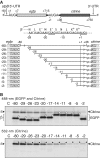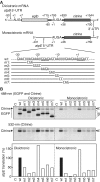The downstream atpE cistron is efficiently translated via its own cis-element in partially overlapping atpB-atpE dicistronic mRNAs in chloroplasts
- PMID: 21846772
- PMCID: PMC3241655
- DOI: 10.1093/nar/gkr644
The downstream atpE cistron is efficiently translated via its own cis-element in partially overlapping atpB-atpE dicistronic mRNAs in chloroplasts
Abstract
The chloroplast atpB and atpE genes encode subunits β and ε of the ATP synthase, respectively. They are co-transcribed as dicistronic mRNAs in flowering plants. An unusual feature is an overlap (AUGA) of the atpB stop codon (UGA) with the atpE start codon (AUG). Hence, atpE translation has been believed to depend on atpB translation (i.e. translational coupling). Using an in vitro translation system from tobacco chloroplasts, we showed that both atpB and atpE cistrons are translated from the tobacco dicistronic mRNA, and that the efficiency of atpB translation is higher than that of atpE translation. When the atpB 5'-UTR was replaced with lower efficiency 5'-UTRs, atpE translation was higher than atpB translation. Removal of the entire atpB 5'-UTR arrested atpB translation but atpE translation still proceeded. Introduction of a premature stop codon in the atpB cistron did not abolish atpE translation. These results indicate that atpE translation is independent of atpB translation. Mutation analysis showed that the atpE cistron possesses its own cis-element(s) for translation, located ~25 nt upstream from the start codon.
Figures







Similar articles
-
Termination codon-dependent translation of partially overlapping ndhC-ndhK transcripts in chloroplasts.Proc Natl Acad Sci U S A. 2008 Dec 9;105(49):19550-4. doi: 10.1073/pnas.0809240105. Epub 2008 Nov 25. Proc Natl Acad Sci U S A. 2008. PMID: 19033452 Free PMC article.
-
Translation of partially overlapping psbD-psbC mRNAs in chloroplasts: the role of 5'-processing and translational coupling.Nucleic Acids Res. 2012 Apr;40(7):3152-8. doi: 10.1093/nar/gkr1185. Epub 2011 Dec 8. Nucleic Acids Res. 2012. PMID: 22156163 Free PMC article.
-
An atpE-specific promoter within the coding region of the atpB gene in tobacco chloroplast DNA.Curr Genet. 1994 Sep;26(3):263-8. doi: 10.1007/BF00309558. Curr Genet. 1994. PMID: 7859310
-
Gene structure and expression of a novel Euglena gracilis chloroplast operon encoding cytochrome b6 and the beta and epsilon subunits of the H(+)-ATP synthase complex.Curr Genet. 1994 Mar;25(3):270-81. doi: 10.1007/BF00357173. Curr Genet. 1994. PMID: 7923415
-
Plastid mRNA translation.Methods Mol Biol. 2014;1132:73-91. doi: 10.1007/978-1-62703-995-6_4. Methods Mol Biol. 2014. PMID: 24599847 Review.
Cited by
-
Chloroplast ATP synthase: From structure to engineering.Plant Cell. 2024 Oct 3;36(10):3974-3996. doi: 10.1093/plcell/koae081. Plant Cell. 2024. PMID: 38484126 Free PMC article. Review.
-
Seamless editing of the chloroplast genome in plants.BMC Plant Biol. 2016 Jul 29;16(1):168. doi: 10.1186/s12870-016-0857-6. BMC Plant Biol. 2016. PMID: 27474038 Free PMC article.
-
Complete plastome sequence of Iodes cirrhosa Turcz., the first in the Icacinaceae, comparative genomic analyses and possible split of Idoes species in response to climate changes.PeerJ. 2019 Apr 1;7:e6663. doi: 10.7717/peerj.6663. eCollection 2019. PeerJ. 2019. PMID: 30972252 Free PMC article.
-
A rapid ribosome profiling method elucidates chloroplast ribosome behavior in vivo.Plant Cell. 2013 Jun;25(6):2265-75. doi: 10.1105/tpc.113.111567. Epub 2013 Jun 4. Plant Cell. 2013. PMID: 23735295 Free PMC article.
-
Transcriptional organization of the large and the small ATP synthase operons, atpI/H/F/A and atpB/E, in Arabidopsis thaliana chloroplasts.Plant Mol Biol. 2012 Jun;79(3):259-72. doi: 10.1007/s11103-012-9910-5. Epub 2012 Apr 19. Plant Mol Biol. 2012. PMID: 22527751
References
-
- Sugiura M. The chloroplast genome. Plant Mol. Biol. 1992;19:149–168. - PubMed
-
- Bock R. Structure, function, and inheritance of plastid genomes. In: Bock R, editor. Cell and Molecular Biology of Plastids. Vol. 19. Potsdam-Golm: Springer; 2007. pp. 29–63.
-
- Deng XW, Gruissem W. Control of plastid gene expression during development: the limited role of transcriptional regulation. Cell. 1987;49:379–387. - PubMed
-
- Mullet JE. Chloroplast development and gene expression. Annu. Rev. Plant Physiol. Plant Mol. Biol. 1988;39:475–502.
-
- Marín-Navarro J, Manuell AL, Wu J, Mayfield SP. Chloroplast translation regulation. Photosynth. Res. 2007;94:359–374. - PubMed
Publication types
MeSH terms
Substances
LinkOut - more resources
Full Text Sources
Research Materials

